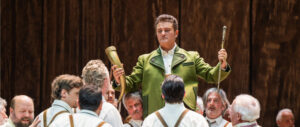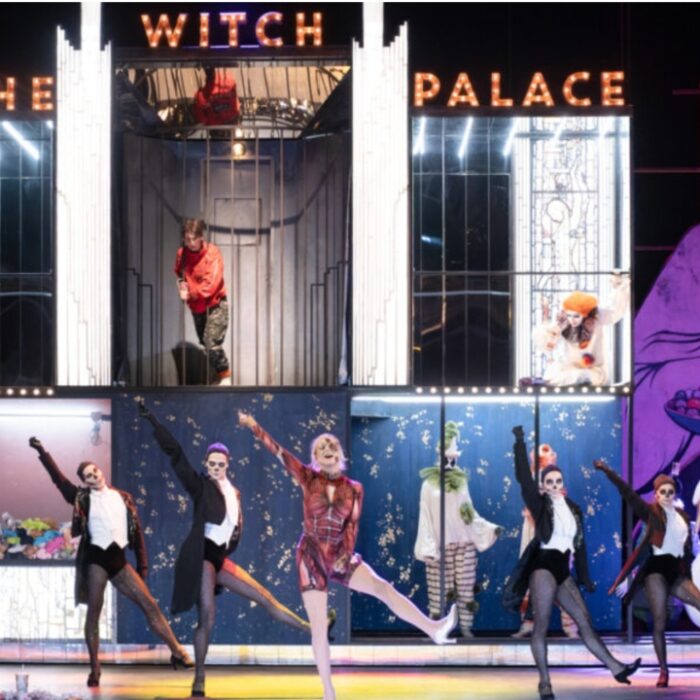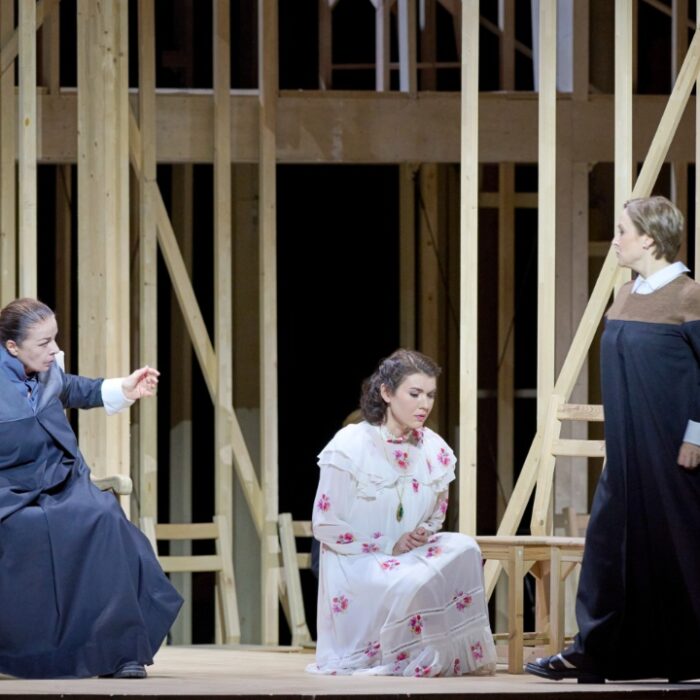
Opernhaus Zürich 2024-25 Review: Lohengrin
By Laura Servidei(Credit: Toni Suter)
In 1850, Richard Wagner premiered a new opera inspired by a figure from medieval German literature: Lohengrin, a member of the Grail Knights’ brotherhood and the son of Parsifal, its king. The story draws from the Legend of the Knight of the Swan, in which a mysterious knight arrives on a magical swan to rescue a damsel in distress—on the condition that she never asks his name or origins.
In Wagner’s opera, the damsel is Elsa von Brabant, the daughter of the late Duke of Brabant, who has been falsely accused of murdering her younger brother by the villainous Telramund. He, in turn, has been manipulated by his evil witch-like wife, Ortrud.
Set in 10th-century Antwerp—then part of the Germanic Empire—the story is steeped in mysticism, portraying an early Christian faith intertwined with superstition and chivalric ideals. A striking example is the “trial by ordeal,” in which Elsa’s innocence is determined by her champion defeating her accuser in a duel. The romantic love between the two protagonists is depicted as a mystical ecstasy, their union transcending earthly doubts and fears, embodying a divine love that leaves no room for human frailty.
An Unsuccessful Production
Andreas Homoki’s production all but ignores this framework, opting instead for a late 19th-century setting—presumably a village in the mountains of Southern Germany, given the men’s Lederhosen and the women’s Dirndl dresses (costumes by Wolfgang Gussmann). The set, also designed by Gussmann, consists of a single wood-paneled room furnished with tables and chairs, where the entire story unfolds. While this unchanging, intimate setting does convey the idea of a tight-knit community, a Wagnerian opera is simply too grand to be confined to one room. After a few hours, the staging feels claustrophobic, and the visuals grow monotonous.
The Personenregie presents the people of Brabant as rustic beer-drinking bumpkins, while a character like Ortrud—who, as one of the last adherents of the pre-Christian faith, should embody ancient wisdom, pagan mysticism, and dark power—is reduced to a petty, vulgar housewife, stomping around the stage with exaggerated grimaces and her hands perpetually planted on her hips.
A Stunning Musical Production, With a Spectacular Protagonist
It is a testament to Wagner’s genius and the performers’ artistry that the music still conjured the full depth of religious solemnity and the transcendent love of Lohengrin and Elsa, even in such an unconventional setting. Conductor Axel Kober guided the Philharmonia Zürich in a tender, enchanting interpretation of the score. The orchestra seemed utterly at ease in this music: the prelude shimmered with transparency and magic, while the Act three prelude brimmed with unbridled joy.
The chorus plays a pivotal role in this opera, functioning almost as a Greek chorus—amplifying the drama’s emotional core and underscoring its most critical moments. The Zürich Opera Choir rose to the occasion magnificently, delivering a performance of flawless precision and profound expressivity. They navigated the lyrical, reverent passages—such as the ethereal arrival of the swan—with a delicate yet resonant touch, while the eruptions of jubilation or fury were rendered with exhilarating vigor and infectious energy.
Piotr Beczała is currently one of the most sought-after tenors in the world for the role of Lohengrin, and his performance in Zürich proved exactly why. His powerful yet elegant voice soared effortlessly through the high notes, exuding both heroism and refinement. What truly stood out, however, was the remarkable palette of vocal colors he brought to every phrase, making his interpretation unforgettable. He was in peak form.
His final aria, “In fernem Land,” was a masterclass in emotional depth—his voice conveying not only his love for Elsa but also his solemn duty to the Grail Brotherhood, as well as the profound sorrow of a man destined to remain apart from ordinary life. And while his “Heil dir, Elsa” had just a touch of huskiness, his “Taube” was nothing short of breathtaking, floating in a pianissimo of exquisite purity and beauty.
As Elsa, Simone Schneider brought a luminous lyric soprano, ideally suited to Wagner’s demands. Her upper register shimmered with silvery brilliance, while her middle voice carried both power and dramatic intensity. She captured Elsa’s innocence and vulnerability with poignant sincerity, and her rendition of the “dream” aria conveyed unwavering faith in her savior with arresting conviction.
Martin Gantner’s Friedrich von Telramund was a commanding presence, his robust baritone exuding the character’s malevolence with a touch of deliberate vocal grit. Though occasionally his voice seemed rough-edged, his high notes rang out with surprising clarity and beauty. The production underscored his humiliation by keeping him in undergarments after his duel—a bold (if somewhat excessive) directorial choice.
Anna Smirnova as Ortrud brought her formidable mezzo-soprano to the role—a voice with such an expansive high range that it has carried her through powerhouse roles like Abigaille, Odabella, and Santuzza, all while anchored by a richly dramatic lower register. Though her top notes occasionally sounded strained, her performance remained fiercely compelling, embodying the vengeful sorceress with palpable relish as she schemed to destroy Elsa’s happiness.
Christof Fischesser as King Heinrich was a regal presence, his stentorian bass and commanding stature perfectly befitting the role. Rounding out the cast was Michael Kraus as the Herald, whose smooth baritone added both warmth and authority to the production.



